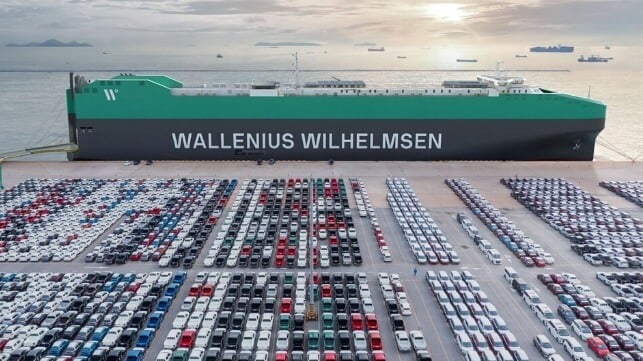World
Wallenius Wilhelmsen Upsizes Car Carriers to Be World’s Largest

Reflecting strong demand across the sector along with the need to improve operating and environmental performance, the car carrier sector is moving to a new generation of larger and more efficient vessels. The major carriers have been “leapfrogging” their competition and today Wallenius Wilhelmsen which takes credit for developing the sector reports it will build the world’s largest capacity pure car and truck carriers.
Wallenius Wilhelmsen will “upsize” four of the 12 vessels currently on order with the Jinling Shipyard in China which is due for delivery starting in 2026. The company revealed in the spring the order for the 12 ships highlighting the increased efficiency and lower environmental impact with a capacity of 9,300 units. Dimensions were not reported but the company said the last four vessels of the class will increase capacity by 25 percent handling approximately 11,700 vehicles, making them the largest PCTCs ever to sail.
The sector’s recent focus had reached a maximum capacity of approximately 8,500 units before the orders for the next generation. In August, Höegh Autoliners celebrated the naming of what it highlighted was the largest car carrier, Höegh Aurora with a capacity of 9,100 units, and the start of its new class which will include an ammonia-ready vessel. CSSC late in 2023 highlighted its new design with a capacity of 10,800 units and Seaspan ordered six of the vessels with an option for four more. They will go under charter to Hyundai Glovis. At the same time, China Merchants received Approval in Principle for an 11,000-unit design.
Wallenius Wilhelmsen reports it will take delivery on the first of the upsized 11,700 unit vessels in late 2027. They highlight that the increased size will reduce costs and contribute to the company’s net-zero ambition.
“Specifically designed for our needs and trading patterns, prepared for net-zero from day one, and purpose built with significant economies of scale, we believe the new upsized Shaper vessels are a class apart,” said Xavier Leroi, EVP & COO Shipping Services at Wallenius Wilhelmsen. “Providing significant savings on fuel and emissions in comparison to the current fleet and with both unparalleled capacity and the highest ramp strength in the order book, these vessels are truly fit for the future.”
When the class was first announced in the spring, the company highlighted designs for alternative fuels, including being equipped for methanol and ammonia ready. They will be outfitted for shore power and a battery system will optimize power generation and reduce energy during maneuvering. The vessel will also have solar panels and air lubrication for the hulls.
The hull form has been optimized both for cargo handling and energy efficiency. Two of the four movable decks will be electrically hoistable. Fire safety will also be enhanced including introducing two fire zones as opposed to the single zone required by regulation.
The lines are working to introduce new capabilities and advantages as competition continues to grow in the sector. Majors including CMA CGM and MSC Mediterranean Shipping have both entered the sector this year while due to capacity constraints, Chinese car manufacturers launched their first dedicated vessels. Vehicle transport is currently one of the fastest-growing segments in the shipping industry.









